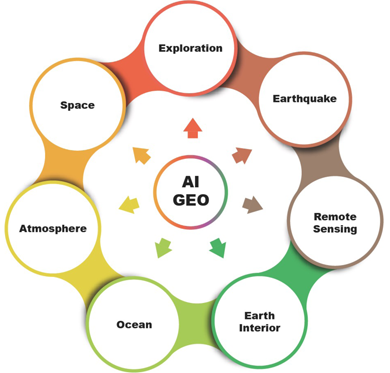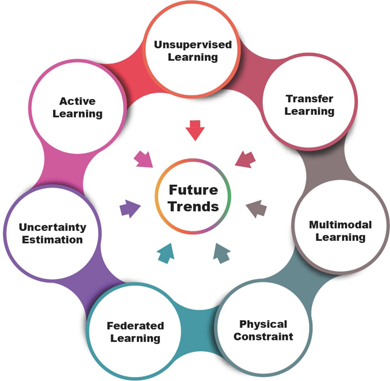As artificial intelligence (AI) continues to develop, geoscientists are interested in how new AI developments could contribute to geophysical discoveries. A new article in Reviews of Geophysics examines one popular AI technique, deep learning (DL). We asked the authors some questions about the connection between deep learning and the geosciences.
How would you describe “deep learning” in simple terms to a non-expert?
Deep learning (DL) optimizes the parameters in a system, a so-called “neural network,” by feeding it a large amount of training data. “Deep” means the system consists of a structure with multiple layers.
DL can be understood from different angles. In terms of biology, DL is a bionic approach imitating the neurons in the human brain; a computer can learn knowledge as well as draw inferences like a human. In terms of mathematics, DL is a high-dimensional nonlinear optimization problem; DL constructs a mapping from the input samples to the output labels. In terms of information science, DL extracts useful information from a large set of redundant data.
How can deep learning be used by the geophysical community?

DL has the potential to be applied to most areas of geophysics. By providing a large database, you can train a DL architecture to perform geophysical inferring. Take earthquake science as an example. The historical records of seismic stations contain useful information such as the waveforms of an earthquake and corresponding locations. Therefore, the waveforms and locations serve as the input and output of a neural network. The parameters in the neural network are optimized to minimize the mismatch between the output of the neural network and the true locations. Then the trained neural network can predict locations of new coming seismic events. DL can be used in other fields in a similar manner.
What advantages does deep learning have over traditional methods in geophysical data processing and analysis?
Traditional methods suffer from inaccurate modeling and computational bottlenecks with large-scale and complex geophysical systems; DL could be helpful to solve this. First, DL can handle big data naturally where it causes a computational burden in traditional methods. Second, DL can utilize historical data and experience which are usually not considered in traditional methods. Third, an accurate description of the physical model is not required, which is useful when the physical model is not known partially. Fourth, DL can provide a high computational efficiency after the training is complete thus enabling the characterization of Earth with a high resolution. Fifth, DL can be used for discovering physical concepts, such as the solar system is heliocentric, and may even provide discoveries that are not yet known.
In your opinion, what are some of the most exciting opportunities for deep learning applications in geophysics?
DL has already provided some surprising results in geophysics. For instance, on the Stanford earthquake data set, the earthquake detection accuracy improved to 100 percent compared to 91 percent accuracy with the traditional method.
In our review article, we suggest a roadmap for applying DL to different geophysical tasks, divided into three levels:
- Traditional methods are time-consuming and require intensive human labor and expert knowledge, such as in the first-arrival selection and velocity selection in exploration geophysics.
- Traditional methods have difficulties and bottlenecks. For example, geophysical inversion requires good initial values and high accuracy modeling and suffers from local minimization.
- Traditional methods cannot handle some cases, such as multimodal data fusion and inversion.
What are some difficulties in applying deep learning in the geophysical community?
Despite the success of DL in some geophysical applications, such as earthquake detectors or pickers, its use as a tool for most practical geophysics is still in its infancy.
Despite the success of deep learning in some geophysical applications its use as a tool for most practical geophysics is still in its infancy.
The main difficulties include a shortage of training samples, low signal-to-noise ratios, and strong nonlinearity. The lack of training samples in geophysical applications compared to those in other industries is the most critical of these challenges. Though the volume of geophysical data is large, available labels are scarce. Also, in certain geophysical fields, such as exploration geophysics, the data are not shared among companies. Further, geophysical tasks are usually much more difficult than those in computer vision.
What are potential future directions for research involving deep learning in geophysics?

In terms of DL approaches, several advanced DL methods may overcome the difficulties of applying DL in geophysics, such as semi-supervised and unsupervised learning, transfer learning, multimodal DL, federated learning, and active learning. For example, in practical geophysical applications, obtaining labels for a large data set is time-consuming and can even be infeasible. Therefore, semi-supervised or unsupervised learning is required to relieve the dependence on labels.
We would like to see research of DL in geophysics focus on the cases that traditional methods cannot handle, such as simulating the atmosphere or imaging the Earth’s interior on a large spatial and temporal scale with high resolution.
—Jianwei Ma ([email protected], ![]() 0000-0002-9803-0763), Peking University, China; and Siwei Yu, Harbin Institute of Technology, China
0000-0002-9803-0763), Peking University, China; and Siwei Yu, Harbin Institute of Technology, China
Citation:
Ma, J., S. Yu (2021), When deep learning meets geophysics, Eos, 102, https://doi.org/10.1029/2021EO162802. Published on 01 September 2021.
Text © 2021. The authors. CC BY-NC-ND 3.0
Except where otherwise noted, images are subject to copyright. Any reuse without express permission from the copyright owner is prohibited.

